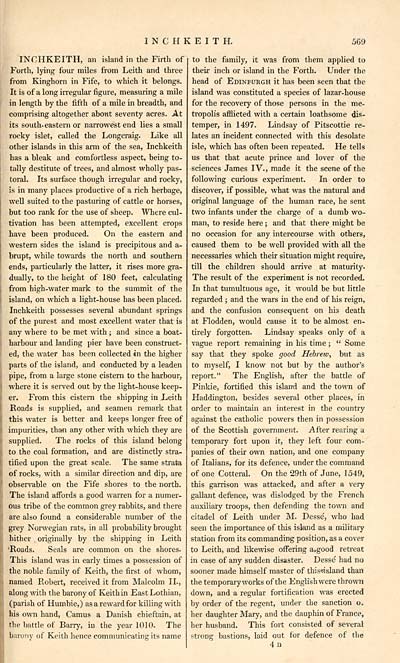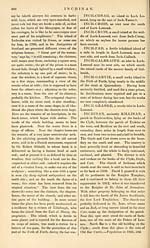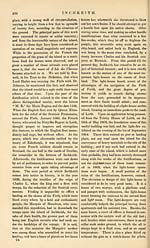Gazetteer of Scotland > Volume 2
(85) Page 569
Download files
Complete book:
Individual page:
Thumbnail gallery: Grid view | List view

1 N C H K E I T H.
569
INOHKEITH, an island in the Firth of
Forth, lying four miles from Leith and three
from Kinghorn in Fife, to which it belongs.
It is of a long irregular figure, measuring a mile
in length by the fifth of a mile in breadth, and
comprising altogether about seventy acres. At
its south-eastern or narrowest end lies a small
rocky islet, called the Longcraig. Like all
other islands in this arm of the sea, Inchkeith
has a bleak and comfortless aspect, being to-
tally destitute of trees, and almost wholly pas-
toral. Its surface though irregular and rocky,
is in many places productive of a rich herbage,
well suited to the pasturing of cattle or horses,
but too rank for the use of sheep. Where cul-
tivation has been attempted, excellent crops
have been produced. On the eastern and
western sides the island is precipitous and a-
brupt, while towards the north and southern
ends, particularly the latter, it rises more gra-
dually, to the height of 180 feet, calculating
from high-water mark to the summit of the
island, on which a light-house has been placed.
Inchkeith possesses several abundant springs
of the purest and most excellent water that is
any where to be met with ; and since a boat-
harbour and landing pier have been construct-
ed, the water has been collected in the higher
parts of the island, and conducted by a leaden
pipe, from a large stone cistern to the harbour,
where it is served out by the light-house keep-
er. From this cistern the shipping in Leith
Roads is supplied, and seamen remark that
this water is better and keeps longer free of
impurities, than any other with which they are
supplied. The rocks of this island belong
to the coal formation, and are distinctly stra-
tified upon the great scale. The same strata
of rocks, with a similar direction and dip, are
observable on the Fife shores to the north.
The island affords a good warren for a numer-
ous tribe of the common grey rabbits, and there
are also found a considerable number of the
grey Norwegian rats, in all probability brought
hither . originally by the shipping in Leith
'Roads. Seals are common on the shores.
This island was in early times a possession of
the noble family of Keith, the first of whom,
named Robert, received it from Malcolm II.,
along with the barony of Keith in East Lothian,
(parish of Humbie,) as a reward for killing with
his own hand, Camus a Danish chieftain, at
the battle of Barry, in the year 1010. The
barony of Keith hence communicating its name
to the family, it was from them applied to
their inch or island in the Forth. Under the
head of Edinburgh it has been seen that the
island was constituted a species of lazar-house
for the recovery of those persons in the me-
tropolis afflicted with a certain loathsome dis-
temper, in 1497. Lindsay of Pitscottie re-
lates an incident connected with this desolate
isle, which has often been repeated. He tells
us that that acute prince and lover of the
sciences James IV., made it the scene of the
following curious experiment. In order to
discover, if possible, what was the natural and
original language of the human race, he sent
two infants under the charge of a dumb wo-
man, to reside here ; and that there might be
no occasion for any intercourse with others,
caused them to be well provided with all the
necessaries which their situation might require,
till the children should arrive at maturity.
The result of the experiment is not recorded.
In that tumultuous age, it would be but little
regarded ; and the wars in the end of his reign,
and the confusion consequent on his death
at Flodden, would cause it to be almost en-
tirely forgotten. Lindsay speaks only of a
vague report remaining in his time ; " Some
say that they spoke good Hebrew, but as
to myself, I know not but by the author's
report." The English, after the battle of
Pinkie, fortified this island and the town of
Haddington, besides several other places, in
order to maintain an interest in the country
against the catholic powers then in possession
of the Scottish government. After rearing a
temporary fort upon it, they left four com-
panies of their own nation, and one company
of Italians, for its defence, under the command
of one Cotteral. On the 29th of June, 1549,
this garrison was attacked, and after a very
gallant defence, was dislodged by the French
auxiliary troops, then defending the town and
citadel of Leith under M. Desse, who had
seen the importance of this island as a military
station from its commanding position, as a cover
to Leith, and likewise offering a^good retreat
in case of any sudden disaster. Hesse - had no
sooner made himself master of thisrisland than
the temporary works of the English were thrown
down, and a regular fortification was erected
by order of the regent, under the sanction o*
her daughter Mary, and the dauphin of France,
her husband. This fort consisted of several
strong bastions, laid out for defence of the
4d
569
INOHKEITH, an island in the Firth of
Forth, lying four miles from Leith and three
from Kinghorn in Fife, to which it belongs.
It is of a long irregular figure, measuring a mile
in length by the fifth of a mile in breadth, and
comprising altogether about seventy acres. At
its south-eastern or narrowest end lies a small
rocky islet, called the Longcraig. Like all
other islands in this arm of the sea, Inchkeith
has a bleak and comfortless aspect, being to-
tally destitute of trees, and almost wholly pas-
toral. Its surface though irregular and rocky,
is in many places productive of a rich herbage,
well suited to the pasturing of cattle or horses,
but too rank for the use of sheep. Where cul-
tivation has been attempted, excellent crops
have been produced. On the eastern and
western sides the island is precipitous and a-
brupt, while towards the north and southern
ends, particularly the latter, it rises more gra-
dually, to the height of 180 feet, calculating
from high-water mark to the summit of the
island, on which a light-house has been placed.
Inchkeith possesses several abundant springs
of the purest and most excellent water that is
any where to be met with ; and since a boat-
harbour and landing pier have been construct-
ed, the water has been collected in the higher
parts of the island, and conducted by a leaden
pipe, from a large stone cistern to the harbour,
where it is served out by the light-house keep-
er. From this cistern the shipping in Leith
Roads is supplied, and seamen remark that
this water is better and keeps longer free of
impurities, than any other with which they are
supplied. The rocks of this island belong
to the coal formation, and are distinctly stra-
tified upon the great scale. The same strata
of rocks, with a similar direction and dip, are
observable on the Fife shores to the north.
The island affords a good warren for a numer-
ous tribe of the common grey rabbits, and there
are also found a considerable number of the
grey Norwegian rats, in all probability brought
hither . originally by the shipping in Leith
'Roads. Seals are common on the shores.
This island was in early times a possession of
the noble family of Keith, the first of whom,
named Robert, received it from Malcolm II.,
along with the barony of Keith in East Lothian,
(parish of Humbie,) as a reward for killing with
his own hand, Camus a Danish chieftain, at
the battle of Barry, in the year 1010. The
barony of Keith hence communicating its name
to the family, it was from them applied to
their inch or island in the Forth. Under the
head of Edinburgh it has been seen that the
island was constituted a species of lazar-house
for the recovery of those persons in the me-
tropolis afflicted with a certain loathsome dis-
temper, in 1497. Lindsay of Pitscottie re-
lates an incident connected with this desolate
isle, which has often been repeated. He tells
us that that acute prince and lover of the
sciences James IV., made it the scene of the
following curious experiment. In order to
discover, if possible, what was the natural and
original language of the human race, he sent
two infants under the charge of a dumb wo-
man, to reside here ; and that there might be
no occasion for any intercourse with others,
caused them to be well provided with all the
necessaries which their situation might require,
till the children should arrive at maturity.
The result of the experiment is not recorded.
In that tumultuous age, it would be but little
regarded ; and the wars in the end of his reign,
and the confusion consequent on his death
at Flodden, would cause it to be almost en-
tirely forgotten. Lindsay speaks only of a
vague report remaining in his time ; " Some
say that they spoke good Hebrew, but as
to myself, I know not but by the author's
report." The English, after the battle of
Pinkie, fortified this island and the town of
Haddington, besides several other places, in
order to maintain an interest in the country
against the catholic powers then in possession
of the Scottish government. After rearing a
temporary fort upon it, they left four com-
panies of their own nation, and one company
of Italians, for its defence, under the command
of one Cotteral. On the 29th of June, 1549,
this garrison was attacked, and after a very
gallant defence, was dislodged by the French
auxiliary troops, then defending the town and
citadel of Leith under M. Desse, who had
seen the importance of this island as a military
station from its commanding position, as a cover
to Leith, and likewise offering a^good retreat
in case of any sudden disaster. Hesse - had no
sooner made himself master of thisrisland than
the temporary works of the English were thrown
down, and a regular fortification was erected
by order of the regent, under the sanction o*
her daughter Mary, and the dauphin of France,
her husband. This fort consisted of several
strong bastions, laid out for defence of the
4d
Set display mode to: Large image | Transcription
Images and transcriptions on this page, including medium image downloads, may be used under the Creative Commons Attribution 4.0 International Licence unless otherwise stated. ![]()
| Gazetteers of Scotland, 1803-1901 > Gazetteer of Scotland > Volume 2 > (85) Page 569 |
|---|
| Permanent URL | https://digital.nls.uk/97431842 |
|---|
| Description | Volume II: Glenbanchor to Zetland. |
|---|---|
| Attribution and copyright: |
|
| Description | By Robert Chambers and William Chambers. Glasgow: Blackie & Son, 1838. 2 volumes. |
|---|---|
| Shelfmark | NF.1461.g.7 |
| Additional NLS resources: | |

